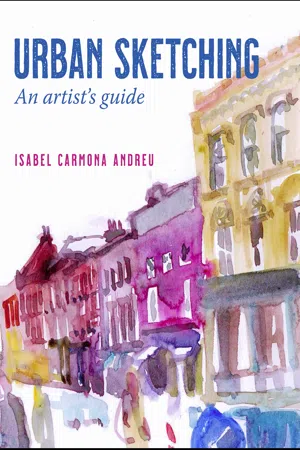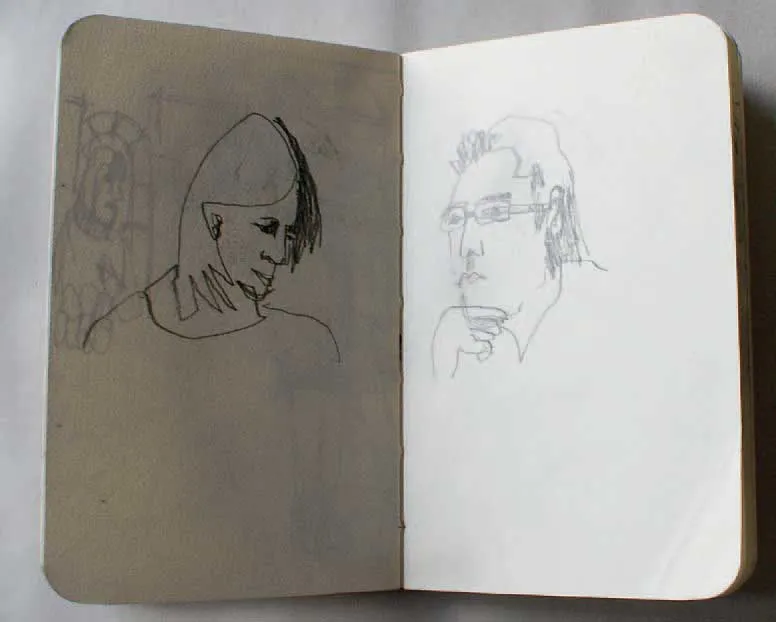
- 128 pages
- English
- ePUB (mobile friendly)
- Available on iOS & Android
eBook - ePub
About this book
Urban sketching is centered on observing and drawing the environment around you, and sharing your drawings with like-minded groups in person and through social media. This book encourages you to get involved by picking up a pen and a sketchbook and trying a range of techniques. It gives advice on composition and how to develop a personal style along with quick exercise ideas in line drawing and demonstrations in colour and paint. Packed with illustrations, this new book is an inspirational handbook that will equip you with the tools and ideas you'll need to embark and thrive on your own unique urban sketching journey. Get hooked on urban sketching, and share your passion for drawing and art with others.
Frequently asked questions
Yes, you can cancel anytime from the Subscription tab in your account settings on the Perlego website. Your subscription will stay active until the end of your current billing period. Learn how to cancel your subscription.
No, books cannot be downloaded as external files, such as PDFs, for use outside of Perlego. However, you can download books within the Perlego app for offline reading on mobile or tablet. Learn more here.
Perlego offers two plans: Essential and Complete
- Essential is ideal for learners and professionals who enjoy exploring a wide range of subjects. Access the Essential Library with 800,000+ trusted titles and best-sellers across business, personal growth, and the humanities. Includes unlimited reading time and Standard Read Aloud voice.
- Complete: Perfect for advanced learners and researchers needing full, unrestricted access. Unlock 1.4M+ books across hundreds of subjects, including academic and specialized titles. The Complete Plan also includes advanced features like Premium Read Aloud and Research Assistant.
We are an online textbook subscription service, where you can get access to an entire online library for less than the price of a single book per month. With over 1 million books across 1000+ topics, we’ve got you covered! Learn more here.
Look out for the read-aloud symbol on your next book to see if you can listen to it. The read-aloud tool reads text aloud for you, highlighting the text as it is being read. You can pause it, speed it up and slow it down. Learn more here.
Yes! You can use the Perlego app on both iOS or Android devices to read anytime, anywhere — even offline. Perfect for commutes or when you’re on the go.
Please note we cannot support devices running on iOS 13 and Android 7 or earlier. Learn more about using the app.
Please note we cannot support devices running on iOS 13 and Android 7 or earlier. Learn more about using the app.
Yes, you can access Urban Sketching by Isabel Carmona Andreu in PDF and/or ePUB format, as well as other popular books in Art & Art Techniques. We have over one million books available in our catalogue for you to explore.
Information
Chapter 1
WHAT TO SKETCH ON AND WHAT TO SKETCH WITH
Urban sketchers have many conversations regarding materials and art supplies. They just love talking about what they use, sharing ideas about drawing tools, colours, palettes, brushes or their inventions for balancing everything when drawing and painting outside in a precarious location. However, simplicity is key. As the essence of urban sketching is being outdoors, portability and comfort are essential requisites of any urban sketching tool. At the simplest level, a sketchbook and a pencil is all that is required. But what sketchbook? What pencil? What happens if colour is also needed?
Breaking down these key questions, the best thing is to think about the surface – what to sketch on? – and the drawing and painting tools – what to sketch with? Below a variety of surfaces are considered and matched with the different tools they are suitable for. Various drawing and painting tools are explored for the diverse means of expression used daily by urban sketchers.

Selection of sketching materials. It is important that any sketching gear is portable and easy to find inside the bag; pencil cases help to organize the materials as well as rubber bands to hold similar materials together.
SURFACES
Paper is the main surface that sketchers use. It can be bought and used loose, clipped to a board (to give you rigidity while you draw/paint) or bound together in a sketchbook.
The sketchbook is normally the preferred way to collect and carry around drawings. It is easy to show and share with others and it helps urban sketchers collect all their drawing efforts together; it will serve as a timeline of daily life, showing progress in skill and communication. For the urban sketcher, a sketchbook is full of memories, of place, food, sounds and smells as well as the physical drawing or painting.
The type of paper used is key to the drawing medium; the surface finish as well as the weight of the paper will need to be chosen carefully.
For line drawing a smooth, white paper is recommended, such as cartridge paper, hopefully of a medium weight of 125 to 150gsm (grams per square metre). The thinner/lighter paper (125gsm) would suffice for pencil drawing. The thicker/heavier paper (150gsm) will show through less when using ink for line work and it may also be able to take on a small amount of water-based colour.
For more elaborate sketches in watercolour, using more than one layer of paint, watercolour paper is best. When pen drawing is used with watercolour, hot press paper is more suitable for its smooth surface. For watercolour painting, with some pencil drawing, however, cold press watercolour paper that has a bit of grain is the straightforward choice.

Choice of papers: hot press is good for watercolour painting and smooth for line drawing, cold press has a good texture for watercolour painting and cartridge paper is best used for drawing and dry media.
Most watercolour sketchbooks have a cold pressed paper weight of 190 to 200gsm, which is suitable for a couple of watercolour layers but is a bit light when many layers of watercolour paint are being applied and stretching the paper on the go is not practicable. John Purcell Paper offers 300gsm watercolour sketchbooks, but a few need to be ordered at one time to make them economical. A good option is to buy loose sheets of 300gsm watercolour paper, of any brand, and make a self-bound sketchbook. This choice is good for personal projects and for sketchers who want to use multiple layers of watercolour.

Bought sketchbooks from various manufacturers: from top to bottom they are Stillman & Birn Gamma Series cream cartridge paper 150gsm; Seawhite concertina and Seawhite landscape, both with cartridge paper 140gsm; John Purcell watercolour paper 300gsm; Hahnemuhle watercolour paper 190gsm; and Seawhite large portrait cartridge 140gsm.

Handmade sketchbooks for various projects. The green marbled paper book with Coptic binding has 300gsm watercolour paper and was prepared for a specific sketching project; the map-covered Japanese stab-bound book has a series of Scottish sketches on a thick leftover printing paper and the pink concertina book collects drawings from the Manchester 2016 urban sketching symposium and has various papers folded into one book.
SKETCHBOOK FORMATS
The choice of paper format refers to the orientation of the paper and whether it is portrait or landscape. Other formats worth exploring are square and concertina (continuously folded) paper. Urban sketchers consider the sketchbook not only as a collection of single pages but also as a set of spreads where drawings go from one side of the page to the other.

The square format for a sketch gives a modern look, easy to share on Instagram without cropping. It has the option of extending to a landscape format as a double page.

A portrait book has an upright rectangular format on a single page but sideways on the spread, the two rectangles of similar proportion. A small portrait sketchbook is ideal to use for discreet portraits and sketches on trains and cafés.

A landscape book has an elongated format, both on a single page or as a double spread. Expanding across both pages of this landscape sketchbook, the wider view of the harbour in Falmouth fits well; this ink pen sketch was done from the top of the lookout tower of the National Maritime Museum of Cornwall.

A concertina book provides a lot of flexibility, as you can choose between a one-page, two-page or a larger number of pages spread, giving the option of expanding the view as you draw. This four-page spread emphasizes the width of this Manchester car park with urban buildings from different times around it.
Sketchbook size
Portability and the degree to which the sketcher would like to be invisible are key parameters when choosing the right sketchbook size. The following sizes are standard rectangular metric sizes. There are also square format sketchbooks that provide a compromise between these sizes. Some sketchbooks will have approximate sizes close to these, based on various ways of cutting a full sheet of paper.
•A small A6 (105 × 148.5mm) book will fit neatly in a handbag or a pocket and is discrete when taken out in crowded places.
•A medium A5 (148.5 × 210mm) book fits in a larger pocket or bag but is more visible when in use.
•A large A4 (210 × 297mm) book will need a larger bag and is clearly noticeable when it is out.
•A very large A3 (420 × 297mm) book will need to be carried about by hand and will need some support (floor, bench or easel) when opened, making it clearly noticeable in use.
•For even larger sizes, the sketcher may need a board and easel to support the book and give it rigidity.

Size and weight matter when thinking about taking the sketchbook around at all times to be ready when the occasion arises for a quick sketch – the largest one here, bigger than A3, does not fit in any bag so would need to be carried separately.
DRAWING AND PAINTING TOOLS
When sketching, each person develops their own style of representing the world around them by using lines, tone and colour. Some sketchers’ work focuses on line and some on tone and colour, and many use a mixed approach. Each type of drawing has its own charm and the expression of the sketcher comes from the combination of these three when choosing the best way of depicting the moment.
Line tools
Pencils are the traditional line tool. A graphite lead inside a hexagonal piece of wood, with different hardness of graphite provides the difference in line thickness and colour. It is worth experimenting with different pencil makes to find the one best liked. Softer pencils (2B, 4B, 6B) give thicker, darker lines than harder pencils (2H, 4H and so on), which are more suitable for technical draughtsman drawings. It is rare to use anything harder than an HB pencil for sketching.

A selection of p...
Table of contents
- Cover
- Halftitle
- Title
- Copyright
- Introduction
- Chapter 1 What to sketch on and what to sketch with
- Chapter 2 Draw what you see, everyone can draw
- Chapter 3 Seeing more, developing style
- Chapter 4 Let there be light
- Chapter 5 Depth and layers
- Chapter 6 Movement
- Chapter 7 Complexity
- Chapter 8 Your world, draw it, share it
- Further information
- Mini glossary
- Credits
- Index